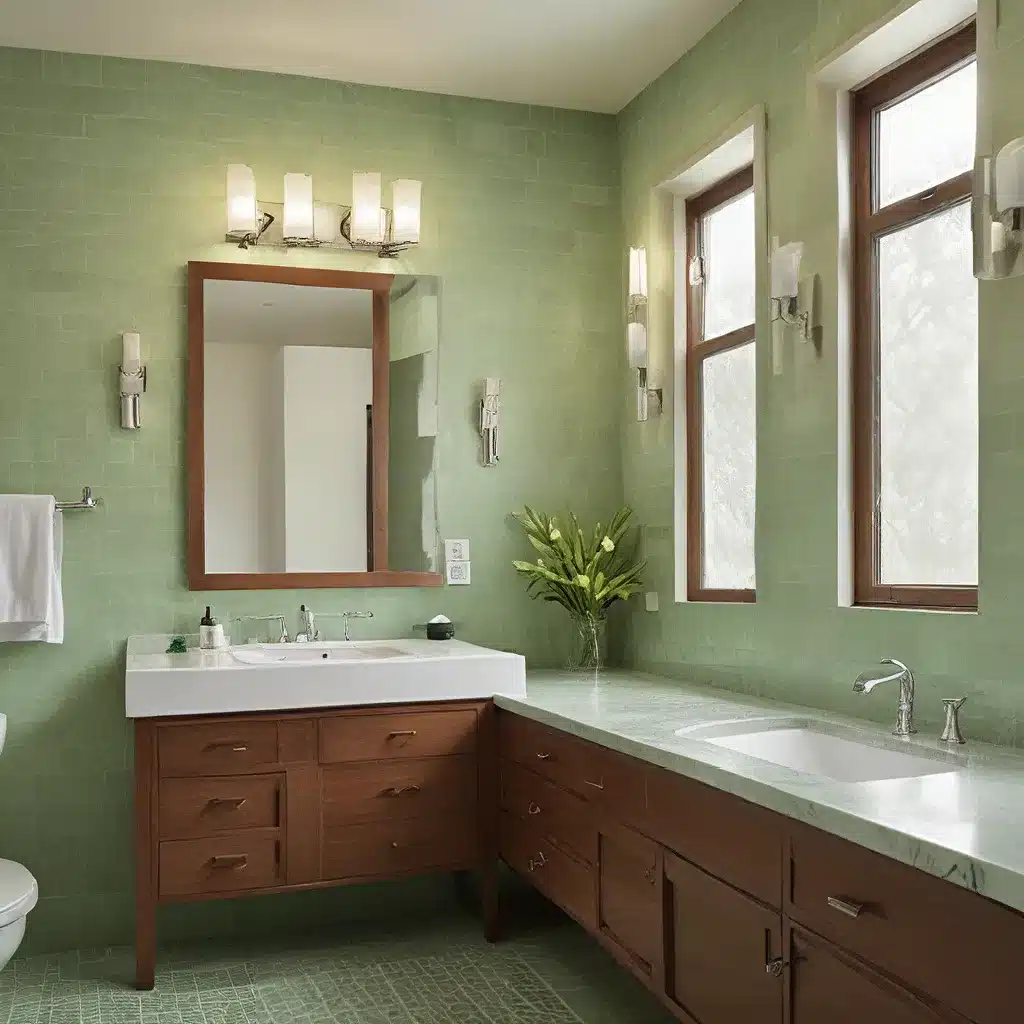
Embracing Sustainability in Bathroom Design
Bathroom renovations have long been associated with excess waste and environmental impact, but the tide is turning. Sustainable bathroom design is rapidly gaining momentum, offering homeowners and designers a path to create beautiful, functional spaces that also prioritize eco-consciousness.
At the heart of this shift is a growing awareness of the importance of minimizing our carbon footprint and reducing resource consumption. By thoughtfully selecting materials, fixtures, and technologies, we can transform the bathroom into a sanctuary of green luxury – one that marries style with environmental responsibility.
Sustainable Bathroom Materials: Beauty and Substance
The foundation of a sustainable bathroom lies in the materials used throughout the space. Traditional options like granite, marble, and ceramic tiles have given way to a wealth of innovative, eco-friendly alternatives.
Reclaimed wood, for example, has emerged as a popular choice for vanities and cabinetry. Not only does it add unique character and rustic charm, but it also reduces the demand for newly harvested timber. Bamboo, a highly renewable grass, is another material gaining traction for its durability, water resistance, and striking visual appeal.
For countertops, recycled glass and quartz composites offer stunning aesthetics while minimizing environmental impact. These materials are often crafted from post-consumer waste, giving new life to discarded items.
Even the often-overlooked plumbing fixtures can contribute to a sustainable bathroom. Low-flow toilets, faucets, and showerheads can significantly reduce water consumption without compromising performance or comfort.
Efficiency and Conservation: Reducing the Bathroom’s Footprint
Beyond material selection, sustainable bathroom design also focuses on improving energy and resource efficiency. This not only benefits the environment but also translates to long-term cost savings for homeowners.
LED lighting, for instance, is a must-have for any eco-conscious bathroom renovation. These energy-efficient bulbs consume far less electricity than traditional incandescent or halogen options, cutting down on both energy use and utility bills.
Implementing water-saving technologies is another crucial element of sustainable bathroom design. Dual-flush toilets, motion-sensor faucets, and recirculating shower systems can dramatically reduce water waste, aligning with the growing emphasis on conservation.
Incorporating natural ventilation strategies, such as strategically placed windows or exhaust fans, can also minimize the need for energy-intensive HVAC systems, further enhancing the bathroom’s environmental performance.
Embracing the Circular Economy: Reducing Waste and Promoting Reuse
Sustainable bathroom design extends beyond material selection and efficiency – it also encompasses the principles of the circular economy, which aims to eliminate waste and maximize the use of resources.
One way to embrace this approach is by prioritizing modular and adaptable design elements. Fixtures and cabinetry that can be easily disassembled, repaired, or repurposed reduce the need for costly and environmentally taxing replacements down the line.
Homeowners can also look for opportunities to recycle and repurpose existing materials during a bathroom renovation. Salvaging and refinishing existing vanities, tubs, or tiles not only reduces waste but also imbues the space with a unique, one-of-a-kind character.
Blending Luxury and Sustainability: The New Bathroom Paradigm
The notion that sustainable design must compromise on style and opulence is a common misconception. In fact, the latest trends in eco-friendly bathroom design demonstrate that luxury and environmental responsibility can coexist harmoniously.
Natural stone, artisanal tiles, and custom-crafted cabinetry can all be sourced and produced in a sustainable manner, offering homeowners the opportunity to create a bathroom that is both visually stunning and environmentally conscious.
Moreover, the growing emphasis on wellness and self-care has led to the integration of biophilic design elements, such as living walls, natural lighting, and lush greenery, further enhancing the luxurious, yet sustainable, ambiance of the modern bathroom.
Maintaining a Sustainable Bathroom: Longevity and Lifestyle
Sustainable bathroom design is not just about the initial renovation – it’s also about long-term maintenance and lifestyle adjustments. Homeowners who embrace this approach must be willing to make ongoing, eco-conscious choices to preserve the integrity of their investment.
This may include regular cleaning with non-toxic, biodegradable products, as well as the proper disposal of waste generated within the bathroom. Encouraging water conservation through mindful habits, such as shorter showers and turning off faucets, can also contribute to the overall sustainability of the space.
By fostering a culture of environmental stewardship within the bathroom, homeowners can ensure that their sustainable design choices continue to have a positive impact for years to come.
The Future of Bathroom Design: Embracing Sustainability
As the demand for eco-friendly living continues to grow, the role of the bathroom in the sustainable home is becoming increasingly vital. Homeowners, designers, and contractors who embrace this shift towards green, responsible design are not only creating beautiful and functional spaces but also contributing to a more sustainable future.
Whether you’re planning a complete bathroom renovation or simply seeking to update your existing space, the opportunities to incorporate sustainable elements are vast and ever-evolving. By staying informed, making mindful choices, and committing to a lifestyle of environmental responsibility, you can transform your bathroom into a sanctuary of sustainable splendor.
Explore the wide range of eco-friendly fixtures, materials, and technologies available on Washbasin Factory to begin your journey towards a green bathroom oasis.